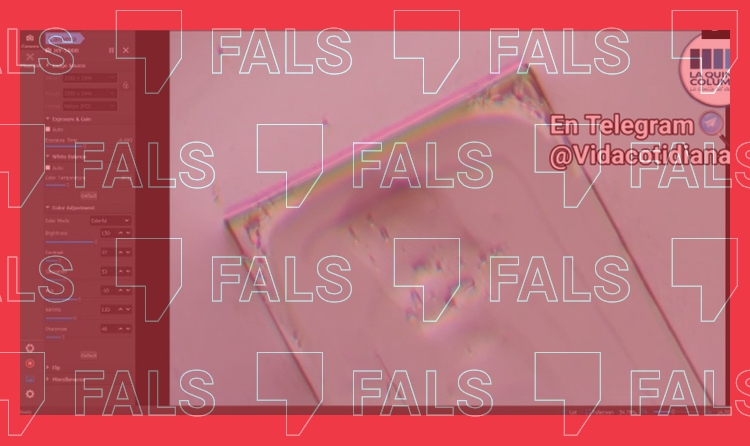The Pfizer vaccines do not contain electronic components

They have been shown on a Twitch program, but both the AEMPS and the EMA deny that the vaccines contain such elements.

Currently making the rounds on Telegram is a video in which Ricardo Delgado, who hosts a programme on Twitch that frequently spreads false content about the vaccines, states what he has found inside a supposed vial of the Pfizer vaccine after emptying it onto a slide to examine its contents under a microscope. Delgado claims to have observed “nanotechnology” with “four square-shaped metallic bits and circuitry”. This is FALSE. Scientific evidence published to date rules out that vials of the Pfizer vaccine contain this type of nanotechnology. The vaccine do contain excipients, which could explain the images in the video, but the crystals visible are certainly not nanotechnology.
Look at what turned up in the Pfizer vaccine. It has four square-shaped metallic bits and circuitry inside. These are electronic components: this is what has formed on the surface of the slide.
As indicated by Delgado in his video, the Pfizer vaccines, which are mRNA vaccines (Spanish only), contain “electronic components”. However, both the Spanish Agency of Medicines and Medicinal Products (Agencia Española de Medicamentos y Productos Sanitarios, or AEMPS) and of the European Medicines Agency (EMA), which are two of the authorities that monitor pharmaceutical products in the European Union (Spanish only), have denied to Verificat that these types of objects have been found in the Pfizer vaccine. “These images do not correspond to any Pfizer vial that has been received. Had that been the case, the strict quality control procedures would have detected it —as has happened with other drugs— and the necessary measures would have been taken”, the AEMPS press office explains.
Methodological errors in the experiment
Verificat has tried, without success, to contact Ricardo Delgado in order to find out about the methodology he employed when he observed the aforementioned crystals. Therefore, we don’t know the specific details of the experiment beyond him allegedly emptying the contents of a vial of the Pfizer vaccine onto a slide, letting it dry for several days and observing in the microscope what was left there afterwards. In the video there is also no explanation of where the alleged vial came from.
First of all, the AEMPS criticise the way in which Delgado allegedly conducted the experiment since “it exhibits obvious flaws that force us to call the result into question”. They insist that it should have been carried out in an environment with the same strict hygienic conditions in which the original test was performed, “because, if not, the very way in which the test was performed favours the entry of contaminants, which produce aberrant results”.
“Leaving the drug out on a slide for several days is an entirely abnormal test condition, which would not routinely be done and would unavoidably affect the result of whatever someone were trying to observe”, explains the press office in an email. Gabriel Alfranca, a PhD student in Nanomedicine and researcher at the Institute of Nanoscience of Aragón (CSIC-UZ), agrees that errors in the execution of the experiment can be observed even just by analysing the way in which the author of the video uses the microscope: “In optical microscopes, which he appears to be using, this level of magnification (1200x, according to Delgado in the video) requires the use of immersion oils, and, based on the way the author switches from one magnification to another, it is clear that it is not being done properly (switching between objectives with immersion oil requires taking a series of steps)”. This, added the researcher, indicates that “he either made a mistake in the level of magnification or he has not used many microscopes like it before”.
What could the crystals that Delgado is talking about be?
Second, the elements that can be observed in the video are not necessarily nanotechnology. “The vaccine contains excipients such as sucrose, which, once the solvent evaporates, can conceivably cause some crystals to form on a slide, the appearance of which is compatible with the images inserted in this email”, the agency explains.
Furthermore, the methodology of leaving the sample to dry for several days “maximises this risk”, since excipients produce “a very sticky residue that, if left out in an uncontrolled environment, is bound to cause all sorts of foreign particles to appear”, Alfranca says. “It is also possible that these crystals are simply dirt”, he concludes.